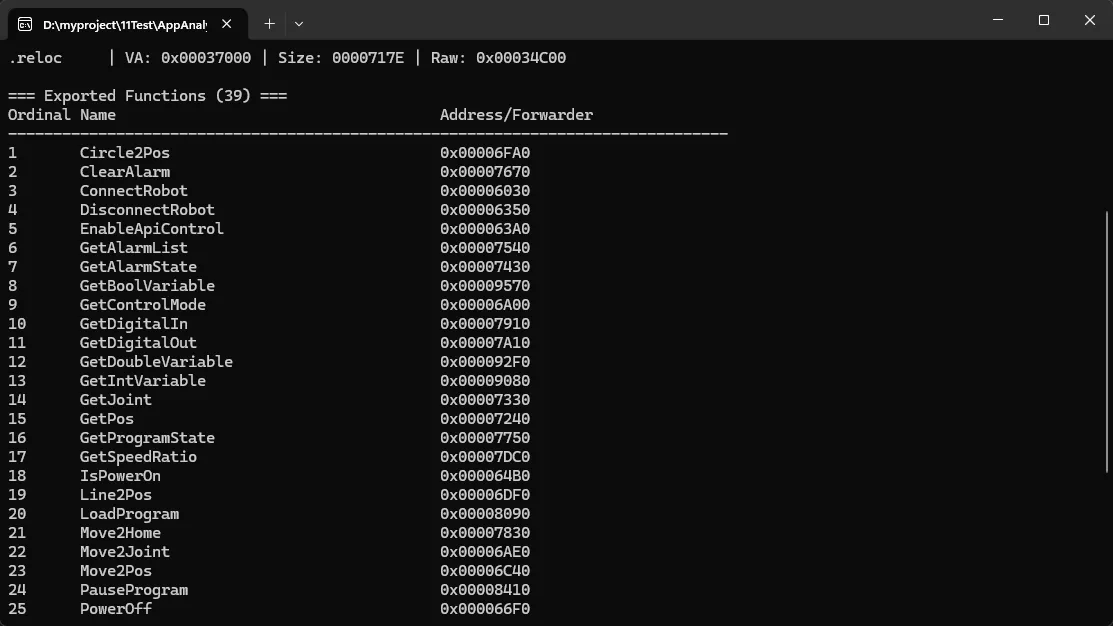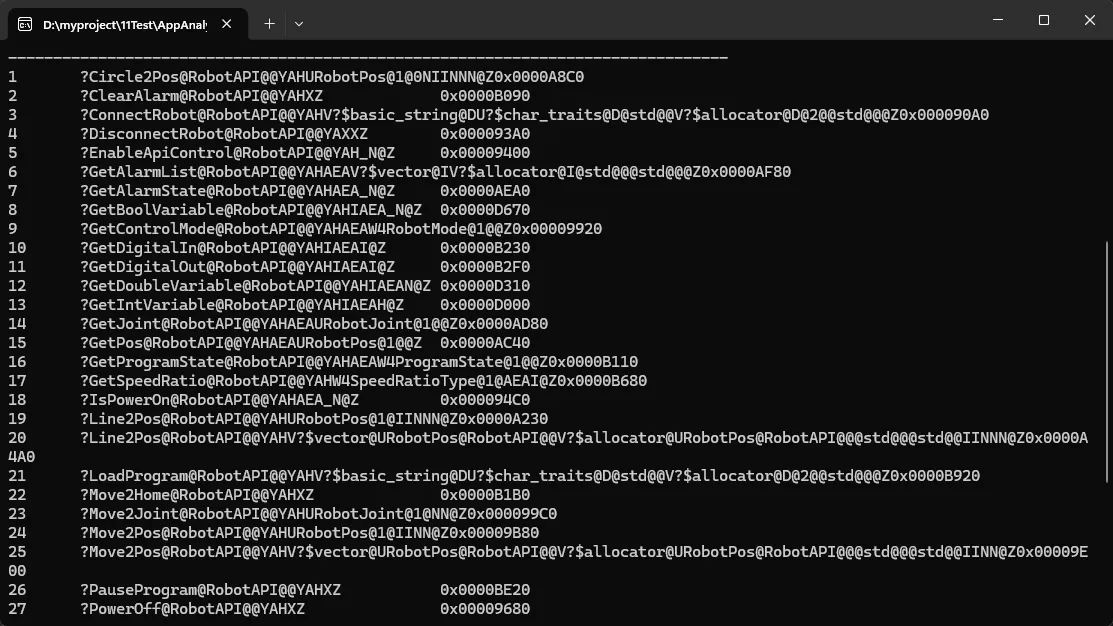目录
你是否曾经遇到过这样的痛苦场景:明明C++ DLL编译成功了,但在C#中用P/Invoke调用时却总是报错"找不到入口点"?特别是x64版本的DLL,更是让人摸不着头脑。今天就来彻底解决这个让无数开发者抓狂的问题!
我将带你打造一个专业级的DLL分析工具,让你能够清晰地看到任何DLL文件的内部结构,再也不用为导出函数的问题而烦恼。
🔍 问题根源分析
为什么x64 DLL调用总是失败?
很多开发者在从x86迁移到x64时都会遇到这个问题。主要原因包括:
- 调用约定差异:x64架构使用统一的调用约定,与x86的多种约定不同
- 名称修饰规则:C++编译器的名称修饰在不同架构下有差异
- 导出方式不同:有些函数只通过序号导出,没有名称导出
- PE文件格式:x64使用PE32+格式,需要不同的解析方法
💡 终极解决方案:专业DLL分析工具
让我们构建一个完整的DLL分析工具,一次性解决所有问题!
🏗️ 核心架构设计
C#using System;
using System.Collections.Generic;
using System.IO;
using System.Runtime.InteropServices;
using System.Text;
namespace DllAnalyzer
{
public class DllAnalyzer
{
private readonly byte[] _dllBytes;
private readonly string _dllPath;
public DllAnalyzer(string dllPath)
{
_dllPath = dllPath;
_dllBytes = File.ReadAllBytes(dllPath);
}
}
}
💡 设计亮点:直接读取二进制文件,绕过系统加载机制,避免依赖问题。
🔧 PE文件头解析核心
C#public DllInfo AnalyzeDll()
{
var info = new DllInfo { FilePath = _dllPath };
try
{
// 验证DOS头 - 每个PE文件的开始标记
if (!ValidateDosHeader())
{
info.ErrorMessage = "Invalid DOS header";
return info;
}
// 获取PE头位置
int peHeaderOffset = BitConverter.ToInt32(_dllBytes, 0x3C);
// 验证PE签名
if (!ValidatePeSignature(peHeaderOffset))
{
info.ErrorMessage = "Invalid PE signature";
return info;
}
// 解析关键信息
ParseCoffHeader(peHeaderOffset + 4, info);
ParseOptionalHeader(peHeaderOffset + 24, info);
ParseSections(info);
ParseExportTable(info);
info.IsValid = true;
}
catch (Exception ex)
{
info.ErrorMessage = ex.Message;
}
return info;
}
⚡ 性能优化:一次性读取文件到内存,避免多次IO操作。
🎯 架构识别的关键代码
C#private void ParseOptionalHeader(int offset, DllInfo info)
{
info.Magic = BitConverter.ToUInt16(_dllBytes, offset);
info.Is64Bit = info.Magic == 0x20B; // PE32+ magic number
// 根据架构选择正确的偏移
int dataDirectoryOffset = info.Is64Bit ? offset + 112 : offset + 96;
// 导出表信息
info.ExportTableRva = BitConverter.ToUInt32(_dllBytes, dataDirectoryOffset);
info.ExportTableSize = BitConverter.ToUInt32(_dllBytes, dataDirectoryOffset + 4);
}
🔥 核心技巧:通过Magic Number (0x20B) 精确识别PE32+格式,这是x64检测的关键!
🚀 导出表解析的精华代码
C#private void ParseExportTable(DllInfo info)
{
if (info.ExportTableRva == 0) return;
// RVA到文件偏移的转换 - 这是关键步骤
uint exportTableOffset = RvaToFileOffset(info.ExportTableRva, info.Sections);
// 解析导出目录表结构
uint nameRva = BitConverter.ToUInt32(_dllBytes, (int)exportTableOffset + 12);
uint ordinalBase = BitConverter.ToUInt32(_dllBytes, (int)exportTableOffset + 16);
uint addressTableEntries = BitConverter.ToUInt32(_dllBytes, (int)exportTableOffset + 20);
uint namePointerRva = BitConverter.ToUInt32(_dllBytes, (int)exportTableOffset + 32);
uint ordinalTableRva = BitConverter.ToUInt32(_dllBytes, (int)exportTableOffset + 36);
info.ExportedFunctions = new List<ExportedFunction>();
// 构建序号到名称的映射
var ordinalToNameMap = new Dictionary<uint, string>();
uint namePointerOffset = RvaToFileOffset(namePointerRva, info.Sections);
uint ordinalTableOffset = RvaToFileOffset(ordinalTableRva, info.Sections);
for (uint i = 0; i < namePointerEntries; i++)
{
uint nameRvaValue = BitConverter.ToUInt32(_dllBytes, (int)(namePointerOffset + i * 4));
uint nameFileOffset = RvaToFileOffset(nameRvaValue, info.Sections);
if (nameFileOffset != 0)
{
string functionName = ReadNullTerminatedString((int)nameFileOffset);
uint ordinal = BitConverter.ToUInt16(_dllBytes, (int)(ordinalTableOffset + i * 2));
ordinalToNameMap[ordinal] = functionName;
}
}
}
💎 金句总结:RVA到文件偏移的转换是PE解析的核心,掌握了这个,PE文件格式就不再神秘!
🔗 地址转换的核心算法
C#private uint RvaToFileOffset(uint rva, List<SectionInfo> sections)
{
foreach (var section in sections)
{
if (rva >= section.VirtualAddress &&
rva < section.VirtualAddress + section.VirtualSize)
{
return rva - section.VirtualAddress + section.PointerToRawData;
}
}
return 0;
}
🎯 实战应用:这个算法解决了虚拟地址到文件物理位置的映射问题,是PE解析的基石。
📊 完整的数据结构定义
C#public class DllInfo
{
public string FilePath { get; set; }
public string DllName { get; set; }
public bool IsValid { get; set; }
public MachineType Machine { get; set; }
public bool Is64Bit { get; set; }
public List<ExportedFunction> ExportedFunctions { get; set; }
public string GetArchitectureString()
{
return Machine switch
{
MachineType.I386 => "x86 (32-bit)",
MachineType.AMD64 => "x64 (64-bit)",
MachineType.ARM => "ARM",
MachineType.ARM64 => "ARM64",
_ => $"Unknown ({Machine})"
};
}
}
public class ExportedFunction
{
public string Name { get; set; }
public uint Ordinal { get; set; }
public uint Address { get; set; }
public bool HasName { get; set; }
public bool IsForwarder { get; set; }
public string ForwarderName { get; set; }
public string GetDisplayName()
{
return HasName ? Name : $"#{Ordinal}";
}
}
🛠️ 使用示例与效果展示
C#class Program
{
static void Main(string[] args)
{
string dllPath = @"D:\\myproject\\4Projects\\SDK\\C#\\32位\\Release\\RobotAPI.dll";
var analyzer = new DllAnalyzer(dllPath);
var info = analyzer.AnalyzeDll();
Console.WriteLine($"Architecture: {info.GetArchitectureString()}");
Console.WriteLine($"Export Count: {info.ExportedFunctions.Count}");
foreach (var func in info.ExportedFunctions.Take(10))
{
Console.WriteLine($"{func.Ordinal:D4} | {func.GetDisplayName()}");
}
}
}


发现一个实际问题,x86的比x64的用起来简单,x64问题不少。
🎨 常见坑点与最佳实践
⚠️ 坑点一:名称修饰问题
C++函数可能被编译器修饰,实际导出名称与代码中的不同。
解决方案:
C++// C++中使用extern "C"避免名称修饰
extern "C" __declspec(dllexport) int MyFunction(int param);
⚠️ 坑点二:调用约定不匹配
x64架构统一使用fastcall,x86需要明确指定。
解决方案:
C#// P/Invoke声明
[DllImport("mydll.dll", CallingConvention = CallingConvention.Cdecl)] // x86
[DllImport("mydll.dll")] // x64默认即可
public static extern int MyFunction(int param);
⚠️ 坑点三:字符编码问题
Windows API使用UTF-16,需要正确处理字符串。
解决方案:
C#[DllImport("mydll.dll", CharSet = CharSet.Unicode)]
public static extern int MyStringFunction([MarshalAs(UnmanagedType.LPWStr)] string str);
🔧 高级功能扩展
📈 性能监控版本
C#public class PerformanceDllAnalyzer : DllAnalyzer
{
private readonly Stopwatch _stopwatch = new Stopwatch();
public override DllInfo AnalyzeDll()
{
_stopwatch.Start();
var result = base.AnalyzeDll();
_stopwatch.Stop();
Console.WriteLine($"Analysis completed in {_stopwatch.ElapsedMilliseconds}ms");
return result;
}
}
🔍 批量分析功能
C#public class BatchDllAnalyzer
{
public List<DllInfo> AnalyzeDirectory(string directoryPath, string pattern = "*.dll")
{
var results = new List<DllInfo>();
var files = Directory.GetFiles(directoryPath, pattern);
Parallel.ForEach(files, file =>
{
try
{
var analyzer = new DllAnalyzer(file);
var info = analyzer.AnalyzeDll();
lock (results)
{
results.Add(info);
}
}
catch (Exception ex)
{
Console.WriteLine($"Error analyzing {file}: {ex.Message}");
}
});
return results;
}
}
🎯 总结与展望
通过这个专业级DLL分析工具,我们彻底解决了C#开发中DLL导出函数的识别问题。
🚀 三个核心要点:
- PE格式解析是理解DLL结构的基础,掌握RVA转换是关键
- 架构识别通过Magic Number精确判断,避免x86/x64混淆
- 导出表分析能够获取完整的函数信息,包括名称和序号导出
💡 收藏级代码模板:完整的DLL分析器代码可以直接应用于实际项目,解决P/Invoke调用问题。
这个工具不仅能帮你调试当前问题,更能让你深入理解Windows PE文件格式,提升底层编程能力。在实际开发中,你还遇到过哪些DLL调用的坑?欢迎在评论区分享你的经验!
💬 互动话题:
- 你在P/Invoke开发中还遇到过哪些奇葩问题?
- 除了DLL分析,你认为这个PE解析技术还能应用到哪些场景?
觉得这个工具有用的话,请转发给更多需要的同行!让我们一起提升C#开发的技术水平! 🔥
相关信息
通过网盘分享的文件:AppAnalyzerC++.zip 链接: https://pan.baidu.com/s/1IlooWSyfGJ3xsOrYEkIsug?pwd=b9bi 提取码: b9bi --来自百度网盘超级会员v9的分享
本文作者:技术老小子
本文链接:
版权声明:本博客所有文章除特别声明外,均采用 BY-NC-SA 许可协议。转载请注明出处!